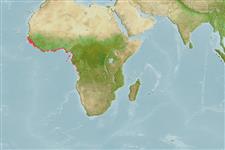Common names from other countries
>
Anguilliformes (Eels and morays) >
Ophichthidae (Snake eels) > Ophichthinae
Etymology: Dalophis: Greek, dalos, ou = torch, burning piece of wood + Greek, ophis = serpent (Ref. 45335).
More on author: Bleeker.
Environment: milieu / climate zone / depth range / distribution range
Ecologia
marinhas; estuarina bentopelágico. Tropical
Eastern Atlantic: Liberia to Congo. Reported from the Casamance and Gambia River (Ref. 28587).
Tamanho / Peso / Idade
Maturity: Lm ? range ? - ? cm
Max length : 53.5 cm TL macho/indeterminado; (Ref. 4455)
Espinhos dorsais (total) : 0; Raios dorsais moles (total) : 0; Espinhos anais: 0; Raios anais moles: 0. Very similar to D. boulengeri. Dorsal origin very near behind gill slits (predorsal length 7.2-9.8% LT). Lateral line pores 73-80 before anus. Vertebrae: 184-191. Brown olive dorsal, whitish yellow ventral.
Burrows in sand or mud in shallow water near estuaries and in rivers (Ref. 4455).
Life cycle and mating behavior
Maturities | Reprodução | Spawnings | Egg(s) | Fecundities | Larvas
Bauchot, M.-L., 1990. Ophichthyidae. p. 92-94. In C. Lévêque, D. Paugy and G. G. Teugels (eds.) Faune des poissons d'eaux douces et saumâtres de l'Afrique de l'Ouest. tome 1. Faune Trop. 28. (Ref. 2846)
Categoria na Lista Vermelha da IUCN (Ref. 130435)
CITES (Ref. 128078)
Not Evaluated
Ameaça para o homem
Harmless
Utilização humana
Ferramentas
Relatórios especiais
Descarregue XML
Fontes da internet
Estimates based on models
Preferred temperature (Ref.
115969): 23.7 - 28, mean 26.7 (based on 66 cells).
Phylogenetic diversity index (Ref.
82804): PD
50 = 0.5312 [Uniqueness, from 0.5 = low to 2.0 = high].
Bayesian length-weight: a=0.00089 (0.00039 - 0.00204), b=3.00 (2.80 - 3.20), in cm Total Length, based on LWR estimates for this (Sub)family-body shape (Ref.
93245).
Nível Trófico (Ref.
69278): 3.8 ±0.6 se; based on size and trophs of closest relatives
Resiliência (Ref.
120179): Médio, tempo mínimo de duplicação da população 1,4 - 4,4 anos (Preliminary K or Fecundity.).
Fishing Vulnerability (Ref.
59153): Moderate vulnerability (41 of 100).
